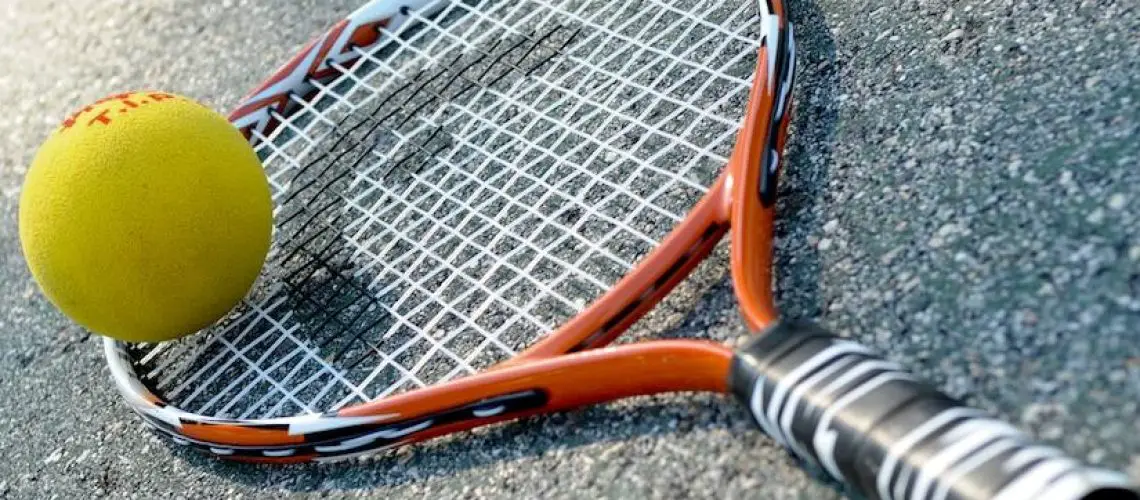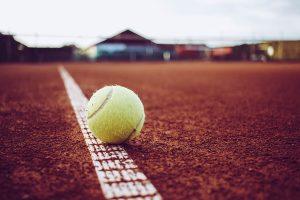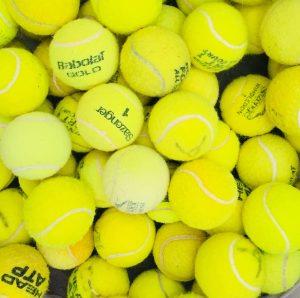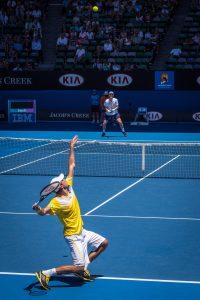We may earn money or products from the companies mentioned in this post.
Brief Overview of Tennis Serves

Tennis serves are an essential aspect of the game, playing a significant role in determining the outcome of a match A well-executed serve can give players a distinct advantage, allowing them to take control of the point from the very beginning There are different types of serves that players can use to strategically outwit their opponents
1 Importance of a Good Serve in the Game
A good serve is crucial because it sets the tone for the entire point It provides an opportunity for players to dictate play by placing their opponent on the defensive right from the start A powerful and accurate serve can result in an ace or force a weak return, giving the server an excellent chance to win points easily
2 Different Types of Serves
Tennis offers various types of serves that players can utilize based on their skill level and match situation:
-
Flat Serve:
The flat serve is known for its speed and direct trajectory over the net It is often used as a weapon to overpower opponents with its sheer pace -
Slice Serve:
The slice serve involves imparting sidespin on the ball, causing it to curve away from the receiver’s dominant hand (right-handers slice away from right-handers). This serve can be effective in creating wide angles and forcing weak returns -
Kick Serve:
The kick serve combines topspin with height, resulting in a high bounce that challenges opponents’ timing and positioning This type of serve is particularly useful on slower surfaces like clay courts
Factors Affecting the Speed of a Tennis Serve

1 Technique and Skill Level
The technique employed by a player and their skill level significantly impact the speed of their serve Proper mechanics, such as a fluid motion, optimal ball toss, and efficient use of body rotation, can generate more power and velocity Additionally, experienced players tend to possess better control over their serves, allowing them to hit with greater speed
2 Physical Strength and Flexibility
A player’s physical attributes play a crucial role in generating serve speed Muscular strength in the upper body, particularly in the shoulders, arms, and core muscles, enables players to generate more force when striking the ball Moreover, flexibility in these areas allows for a larger range of motion during the service motion, leading to increased racket head speed
3 Equipment Used
The equipment used by players can also affect the speed of their serves Advanced racket technologies that incorporate lightweight materials and aerodynamic designs can enhance swing speeds Similarly, using high-quality tennis balls that offer good compression properties can result in faster serves due to better energy transfer upon impact
When it comes to measuring the speed of a tennis serve, professional matches rely on advanced technology to provide accurate and reliable results Two primary methods used in these matches are radar guns and the Hawk-Eye system
Radar guns have been a staple in tennis for many years, revolutionizing the way serve speeds are measured This technology has evolved over time, with early versions being bulky and less precise However, advancements in radar gun technology have made them more portable and accurate than ever before
While radar guns offer a convenient way to measure serve speeds, they do have their limitations Factors such as wind conditions and player positioning can affect the accuracy of the readings Additionally, radar guns capture only instantaneous velocities and may not provide a complete picture of the entire serve motion
In recent years, the Hawk-Eye system has gained popularity in professional tennis matches for its ability to accurately measure serve speeds This computer-based system uses multiple cameras positioned around the court to track the trajectory of the ball with great precision
The Hawk-Eye system offers several features and benefits that make it an ideal choice for measuring serve speeds It provides real-time data on both first and second serves, allowing players and coaches to analyze their performance instantly The system also eliminates human error by providing automated measurements
So how exactly does the Hawk-Eye system work? It uses triangulation techniques combined with high-speed camera footage to calculate the speed of each serve By tracking multiple points on the ball’s trajectory frame by frame, it generates highly accurate velocity measurements that take into account not just instantaneous speed but also changes throughout the entire shot
In conclusion, measuring the speed of a tennis serve in professional matches involves cutting-edge technology like radar guns and the Hawk-Eye system While radar guns have been instrumental in this field for many years, newer systems like Hawk-Eye offer enhanced accuracy and additional features that make them valuable tools for players and coaches alike
Average Tennis Serve Speeds by Skill Level

When it comes to tennis, the speed and accuracy of your serve can make all the difference in a match Understanding average serve speeds across different skill levels can provide valuable insights for players looking to improve their game Let’s explore the average tennis serve speeds by skill level, starting with amateur players
Amateur Players
1 Beginners:
If you’re just starting out in tennis, mastering the basic serving technique is crucial Beginners often focus on developing a consistent toss and learning how to generate power from their legs and core While beginners may not possess lightning-fast serves, they can typically achieve speeds ranging from 50-70 miles per hour (80-113 kilometers per hour).
2 Intermediate Players:
As players progress to an intermediate level, they begin refining their serving technique to increase speed and precision This involves incorporating more shoulder rotation, using proper pronation of the forearm, and optimizing timing for maximum velocity Intermediate players usually see an improvement in their serve speed, reaching an average range of 70-90 miles per hour (113-145 kilometers per hour).
Professional Players
1 Male Players:
In men’s tennis history, we’ve witnessed some incredible servers who have left spectators awestruck with their blistering serves Names like Andy Roddick and Ivo Karlovic come to mind when discussing famous fast servers among male players On the professional circuit, average serve speeds can vary depending on tournament level and player rankings but generally fall within the range of 110-140 miles per hour (177-225 kilometers per hour).
2 Female Players:
The women’s game has also seen its fair share of exceptional servers Players like Serena Williams and Venus Williams have consistently displayed impressive serve speeds throughout their careers On the professional circuit, average serve speeds for female players typically range from 90-120 miles per hour (145-193 kilometers per hour), showcasing their power and athleticism
Understanding these average tennis serve speeds across different skill levels can provide valuable benchmarks for players to strive towards Whether you’re a beginner looking to improve your technique or a professional aiming to enhance your speed, honing your serving skills can give you a competitive edge on the court
Techniques and strategies for faster serves

Improving your serve speed requires a combination of proper technique and strategic positioning One essential aspect is mastering proper footwork and body positioning By positioning yourself correctly on the court, you can generate more power and maximize the efficiency of your serve
The toss is another crucial factor in generating optimal power during a serve It’s important to practice tossing the ball consistently at the right height and position This allows you to make solid contact with the ball, resulting in a more powerful serve
In addition to footwork and toss, efficient use of wrist snap and racket acceleration techniques can significantly enhance your serve speed By snapping your wrist at the right moment as you make contact with the ball, you can add extra speed and spin to your serve
Strength training exercises specific to serving power development

To improve your serving power, it’s essential to incorporate strength training exercises into your routine Core strengthening exercises are particularly beneficial for generating power from your core muscles
Variations of planks, such as side planks or plank rotations, engage multiple muscle groups in your core, helping you develop stability and explosiveness in your serves Russian twists are also effective in targeting core muscles while simulating rotational movements involved in serving
In addition to core exercises, it’s crucial to focus on strengthening shoulder and arm muscles Rotator cuff strengthening exercises help stabilize the shoulder joint, reducing the risk of injury while improving serve power Tricep dips and push-ups are excellent options for building arm strength that translates into more forceful serves
Flexibility training for injury prevention and improved serving motion

To prevent injuries and optimize your serving motion, incorporating flexibility training into your routine is vital Dynamic stretching routines before playing can warm up your muscles and increase their elasticity, allowing for a more fluid and powerful serve
After playing, static stretching routines help cool down your muscles and improve flexibility Stretching exercises such as shoulder stretches, hamstring stretches, and chest stretches can alleviate muscle tension and reduce the risk of strains or imbalances that may hinder your serve speed
Conclusion

Throughout this article, we have explored various techniques and frameworks to improve your serve speed in tennis We discussed the importance of proper technique, body positioning, and using the right equipment Additionally, we highlighted the role of strength and conditioning exercises in enhancing your serve power By implementing these strategies consistently and practicing diligently, you can take your serving game to new heights
Encouragement for readers to practice and improve their serve speed
Now that you have a solid understanding of the key factors that contribute to an effective serve, it’s time to put your knowledge into action Remember that mastering any skill takes time and effort, so be patient with yourself as you work towards improving your serve speed Consistent practice combined with a growth mindset will lead to significant improvements over time
Invitation for reader feedback, questions, or suggestions
We hope you found this article helpful in your quest for a faster tennis serve If you have any questions about the techniques discussed or if there are specific topics you would like us to cover in future articles, please feel free to reach out Your feedback is valuable to us as we strive to provide content that caters to our readers’ needs
Useful Links

Fastest recorded tennis serves
Science explains why female tennis players can serve as …
How Fast Do Professional Tennis Players Hit the Ball?
Top 15 fastest women’s tennis serves in the history of …
How fast do pro tennis players hit the ball?
How Fast Is A Wheelchair Tennis Serve?
average first serve speed wta
Serve Speed Matters
10 Fastest Tennis Serves of All Time
Serena Williams’ Serve Dominates Tennis, Winning 82% …
Half-Fast
How fast is the average tennis serve?
Serve speed – Heavy Topspin
This Is How Fast a Tennis Serve Looks Like
The Fastest Tennis Serves Ever
What is the Fastest Tennis Serve of All Time?
Grand Slam men’s singles tennis 1991-2009






